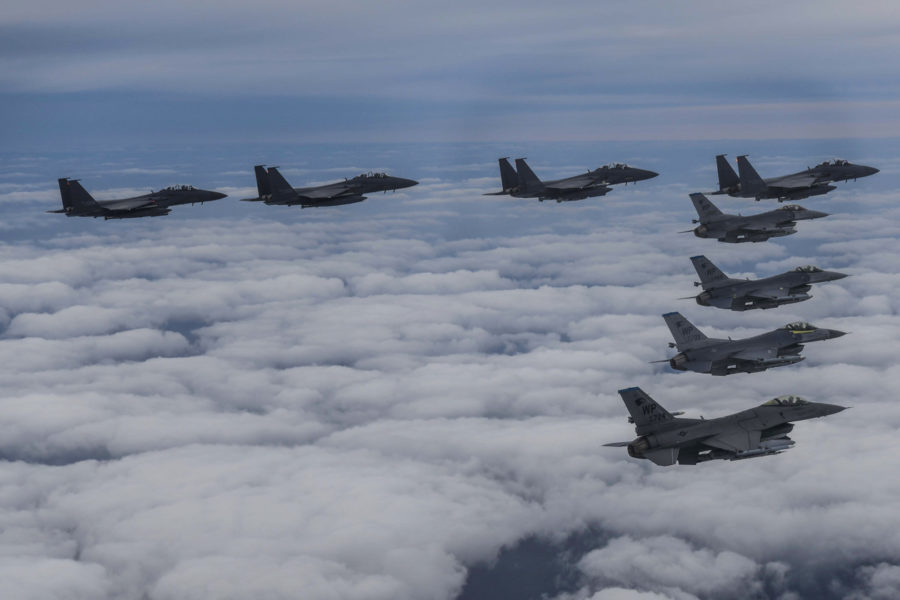The U.S. military and allied forces engaged in a robust response to a North Korean missile test Oct. 4.
The Department of Defense released video Oct. 5 showing four South Korean Air Force F-15K Slam Eagles and four U.S. Air Force F-16 Fighting Falcons joining together in a show of force in response to North Korea’s recent missile tests. The two air forces formed a combined attack squadron to strike the uninhabited South Korean island of Jikdo in the Yellow Sea, according to U.S. Forces Korea.
A F-15 dropped two Joint Direct Attack Munition (JDAM) guided bombs, successfully hitting the target. The exercise was in response to the latest moves by North Korea, showing that the two air forces can conduct precision strikes to take out threats.
“South Korea and the United States demonstrated their will to respond sternly to any Northern threats as well as their capabilities to conduct a precision strike at the origin of provocations based on the alliance’s overwhelming forces,” the South Korean Joint Chiefs of Staff said in a press release, according to Yonhap news agency.
So far, North Korea has been silent on its recent launches.
“It goes without saying that any constructive positive communication is welcome,” Pentagon Press Secretary Brig. Gen. Pat Ryder said Oct. 4. “Firing missiles is not a good way to do that.”
“In the meantime, we will continue to be prepared to defend our allies,” he added.
Tail markings on the U.S. F-16s involved in the JDAM mission indicated the aircraft belonged to the 8th Fighter Wing headquartered at Kunsan Air Base, South Korea. U.S. Forces Korea did not immediately respond to requests for further details on the strike.
The U.S. Air Force bilateral strike in South Korea was just one of many responses by American forces, including other live-fire drills.
U.S. forces in Korea launched surface-to-surface missiles of their own, sending four Army Tactical Missile System (ATACMS) toward the sea. South Korea fired two ballistic missiles, one of which malfunctioned and crashed at an air base, according to reports. Those launches were not intended to strike North Korea, formally known as the Democratic People’s Republic of Korea.
In addition to the live-fire exercises with South Korea, properly the Republic of Korea, U.S. Marine Corps F-35Bs joined the Japanese Air Self-Defense Force over the Sea of Japan in response to the test.
U.S. Navy assets may also be heading toward the Korean Peninsula. According to South Korea, the U.S. Navy is sending the USS Ronald Reagan Carrier Strike Group (CSG) back to its coast. The group took part in exercises there in September before joining South Korean and Japanese forces in anti-submarine drills. The U.S. Seventh Fleet told Air & Space Forces Magazine the “Ronald Reagan Carrier Strike Group is currently operating in the Sea of Japan” but did not comment on future plans.
The recent tests by North Korea, which possesses nuclear weapons, are the most provocative move by the authoritarian regime since 2017. The Oct. 4 test provoked considerable alarm as the missile flew over northern Japan before landing in the ocean outside of Japanese waters. Air raid sirens rang out in Tokyo, and authorities in Hawaii had to assure citizens that the missile did not pose a threat to the U.S. island.
The North Korean tests appeared to be in response to the arrival of the Reagan in the area and a visit by Vice President Kamala Harris to the Demilitarized Zone (DMZ) separating North and South Korea.
According to some analysts, open source information suggests the missile tested Oct. 4 by North Korea has enough range to hit the U.S. territory of Guam in the western Pacific, home to major American Air Force and Navy bases. North Korea has rapidly increased its missile tests following a several-year lull. It has fired about 40 missiles in 2022.
“I’m pretty confident in my capability today against the North Koreans,” Gen. Glen D. VanHerck, head U.S. Northern Command (NORTHCOM) and North American Aerospace Defense Command (NORAD), said at AFA’s Air, Space & Cyber Conference in September.
U.S. Secretary of Defense Lloyd J. Austin III called his South Korean counterpart Oct. 4 to address North Korea’s latest launch.
“They agreed that it was a serious escalation and a clear violation of United Nations Security Council resolutions,” according to the Defense Department readout of the call.
President Joe Biden also called Japanese Prime Minister Fumio Kishida. The U.S. does not have diplomatic relations with North Korea, but a U.S. special representative for the country held a trilateral call with envoys from Japan and South Korea, according to the State Department. An urgent meeting of the United Nations Security Council was held Oct. 5. The U.S. promised that North Korea’s missile tests would continue to be answered with appropriate U.S. demonstrations of force.
“We are taking appropriate defense and deterrent steps with allies and partners,” Secretary of State Antony Blinken said Oct. 5. “I think what we’re seeing is that if they continue down this road, it will only increase the condemnation, increase the isolation, increase the steps that are taken in response to their actions.”
Shortly after Blinken’s comments, the South Korean military said that North Korea had launched two more ballistic missiles, this time towards its eastern waters. It was the sixth round of missile launches in 12 days.


